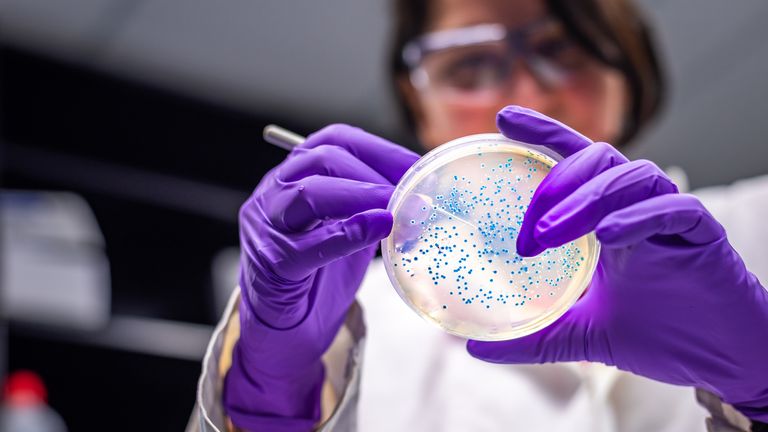More than a hundred cases of E.coli have been detected in the UK as a result of a single outbreak.
At least 37 people have been admitted to hospital as a result – and the UK Health Security Agency (UKHSA) has warned cases are likely to rise.
The 113 cases recorded so far include people aged from two years old to 79, with the majority of the infections in young adults.
But what is E.coli, what are the symptoms of infection – and what has happened in previous outbreaks?
What is E.coli?
Short for Escherichia coli, E.coli is a bacteria that is commonly found in the lower intestine of warm-blooded organisms, the World Health Organisation (WHO) says.
Most E.coli strains are harmless but some can cause serious food poisoning.
That is the case with Shiga toxin-producing E.coli (Stec), a bacterium that can cause severe foodborne disease.
All the cases recorded in this latest outbreak contain Stec.
There are typically around 1,500 cases of Stec over a full year in the UK, according to the UKHSA.
How it spreads
Primary sources of Stec outbreaks are raw or undercooked ground meat products, raw milk, and faecal contamination of vegetables, WHO says.
It is often transmitted by eating contaminated food but can also be spread by close contact with an infected person, as well as direct contact with an infected animal or its environment.
The UKHSA has ruled out the disease spreading through water, saying there was “currently no evidence linking the outbreak to open farms, drinking water or swimming in contaminated seawater, lakes or rivers”.
This outbreak is believed to be linked to a “nationally distributed food item“, according to the UKHSA, but the agency has not given more details on which food could be a source of the infection.
Symptoms of Stec
The main symptoms are stomach cramps, severe and sometimes bloody diarrhoea, vomiting and fever, according to the UKHSA.
Some people may only get mild diarrhoea, or even show no symptoms at all.
Symptoms can last up to two weeks in cases without complications, the UKHSA adds.
For some patients, mainly children, it can cause haemolytic uraemic syndrome (HUS) – a serious life-threatening condition resulting in kidney failure.
In an information leaflet, the UKHSA says that HUS may occur up to two weeks after the start of the diarrhoea.
It adds: “If your symptoms do not go away or you develop easy bruising, feel you are passing less urine than usual or your urine is pink/brown in colour, please urgently seek medical advice as these symptoms could indicate the start of HUS and you may need further tests.”
A small proportion of adults may develop a similar condition called thrombotic thrombocytopenic purpura (TTP).
How do you treat it?
There is no specific treatment for Stec infection and it will usually clear itself within a week. It is important to drink plenty of fluids as diarrhoea can lead to dehydration.
Antibiotics are not recommended and are likely to increase the risk of getting complications such as HUS, the UKHSA says.
E.coli health advice
To reduce the risk of catching and spreading the disease, the UKHSA has advised:
• Regularly washing your hands with warm water and soap – alcohol gels do not kill all of the bugs that cause diarrhoeal illness
• Following food hygiene measures such as washing fruit and vegetables and cooking food properly
• If you have diarrhoea and vomiting, you should not prepare food for others and avoid visiting people in hospitals or care homes to avoid passing on the infection
• You should not return to work, school or nursery until 48 hours after your symptoms have stopped.
Have there been outbreaks like this in the UK before?
There were 27 Stec cases recorded during an outbreak in June last year which was linked to mince beef products.
In 2022, there was an outbreak that caused more than 259 people to get ill between August and the end of October. The agencies investigating suggested a salad had possibly caused the cases.
It’s not uncommon for products to be recalled over fears of outbreaks, as was the case with five cheese products last December.
What about in the US?
E.coli has been a major concern in America at times, with romaine lettuce heavily linked to outbreaks in 2018, when it hit 22 US states.
Officials started urging restaurants and grocery stores to replace romaine lettuce with alternatives if they couldn’t confirm its origin or source it from outside of Yuma, Arizona, as authorities investigated if the city was the source of the outbreak.
A report by the US Food and Drug Administration in 2022 stated the way romaine lettuce from Yuma was being stored may have allowed E.coli to survive on the food for longer.
